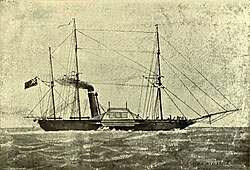Birkenhead (ship)
|
Contemporary drawing of the Birkenhead
|
||||||||||||
|
||||||||||||
|
||||||||||||
|
||||||||||||

The HMS Birkenhead was a troop ship the Royal Navy originally and was in 1845, the frigate in Birkenhead built in North West England. She was an iron ship with a length of 64 meters and a weight of 1,422 tons and was propelled by two steam engines. Initially the ship was called Vulcan . The name was changed in 1848 after a renovation. On February 26, 1852, the Birkenhead sank off South Africa.
The catastrophe
The Eighth Border War was an episode of the hundred year old conflict between the colonists of Cape Agulhas and the Xhosa peoples of South Africa .
During this time, the Birkenhead was converted into a troop transport to bring reinforcements to the Cape. On February 7, 1852, she set sail in Queenstown, Ireland .
On board were estimated (figures vary depending on the source):
She arrived in Cape Town in mid-February . After the sick had been brought ashore and fresh water, provisions and horses had been taken on board, she continued her voyage to Port Elizabeth on February 25, weather permitting.
After less than 160 nautical miles and at a speed of 8 kn, the plumb line indicated a depth of only 22 meters at 1.50 a.m. at Danger Point (near Gansbaai ) on February 26th . In his surprise, the officer on watch ordered the plumb bob to be ejected again, but at that moment the ship was already running onto a rock not shown on the nautical chart.
The incoming water flooded the lower deck of the troops, where hundreds of soldiers were surprised in their sleep and drowned. Nevertheless, with remarkable discipline, the other men took up their positions on deck and remained calm while the dinghies were lowered into the water. There were only eight boats - which wasn't nearly enough for everyone on board. Only three of these could be dropped off. Another was smashed by the falling chimney.
The horses were driven into the water so they could swim on land, but the animals were attacked by sharks . 25 minutes after the accident, at 2:20 a.m., the Birkenhead broke apart and sank.
Several of the crew and soldiers drowned or were killed by sharks. At least more than 60 men managed to reach the bank, clinging to debris, and 40 more were freed from the rigging the next day . According to the list, a total of 193 out of 643 people survived.
The Birkenhead Rule

The well-known rescue order “ Women and children first! ", Which is also known as the" Birkenhead rule "(" Birkenhead Drill "), stems from the fact that the women and children among the passengers on board were first sent into the small number of existing boats. Lieutenant Colonel Alexander Seton, who issued this command and thus replaced the "each for himself!" That was customary up to that point in time, was also killed - like his captain. All women and children, however, survived.
Queen Victoria later commissioned a memorial to be built in London's Royal Hospital, Chelsea , to honor the bravery and discipline of the 445 men who perished.
literature
- Allan Kayle: Salvage of the Birkenhead. Southern Book Publishers, Bergvlei, Johannesburg 1990, ISBN 1-86812-260-3 .
Web links
- A tribute to the soldiers aboard HM Transport Birkenhead , detailed description
- Shipwreck website , more information
